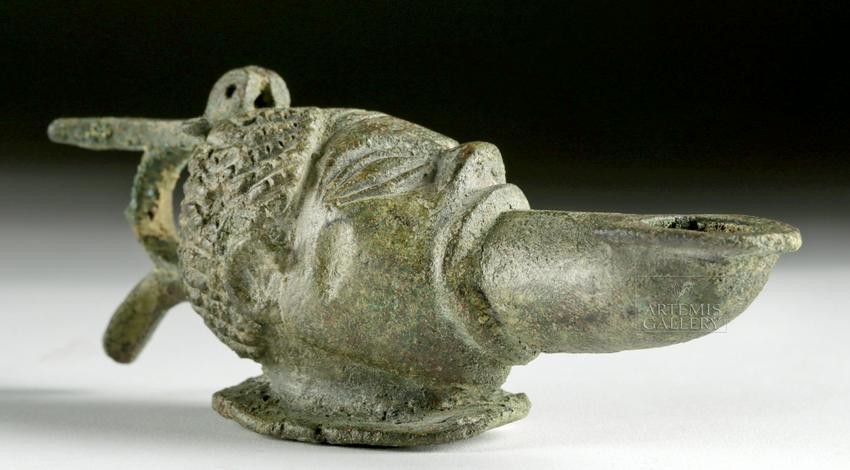Striking Roman Bronze Oil Lamp - Nubian Form
**Originally Listed At $1500**
Roman, Imperial period, ca. 1st to 3rd century CE. A detailed, striking cast bronze oil lamp in the form of the head of an African, who would have been known as an Ethiopian (Aethiops) or Nubian to the Romans. The head is relatively naturalistic until the nose, at which point it elongates into a huge mouth with a hexagonal spout emerging from it like a monstrous tongue. The eyes are large beneath huge arched eyebrows. The raised and incised details of the hair cover the back of the head. The remains of a hinge for a lid are present on the forehead. The head stands on a wide, flaring foot. An ornate, looped handle, made from three pieces of bronze, extends backward from the top of the head. Size: 1.75" L x 6.2" W x 2.25" H (4.4 cm x 15.7 cm x 5.7 cm)
The Romans had extensive contacts with people from Saharan and sub-Saharan Africa (in addition to variously occupying land in Egypt and western North Africa). Gold, food, spices, slaves, textiles, coinage, and even exotic animals were part of the robust trade between these regions. Some Africans lived in Rome, and some notable examples ascended to high social status. Well-read Romans regarded the kingdom of Ethiopia - which they used to refer to everything south of Egypt - as a place to be respected. However, in Roman mythology and literature, black skin was a sign of an inhabitant of the Underworld - for example, Charon is described not only as having black skin, but also as having the facial features of an Aethiops by multiple Classical authors, including Ovid, Pliny, and Virgil. Actual African and Egyptian performers played theatrical roles of Underworld characters, and according to Cassius Dio, Emperor Domitian (r. 81-96 CE) threw a dinner party for Senators he disliked where he made his adolescent slaves paint themselves black to represent the Underworld in order to terrify his guests. What Romans intended by their artistic depictions of Africans is unclear, and remains a point of research and debate.
Provenance: private East Coast, USA collection; ex-Dr. Sid Port collection, California, USA, acquired in the 1980s
All items legal to buy/sell under U.S. Statute covering cultural patrimony Code 2600, CHAPTER 14, and are guaranteed to be as described or your money back.
A Certificate of Authenticity will accompany all winning bids.
We ship worldwide to most countries and handle all shipping in-house for your convenience.
#143883
Condition Report: Smooth grey green patina on surface. Light deposits overall. Nicely preserved form and details. Hinge and lid are lost, with bending to connection area. Still a strong representation.
View it on
Estimate
Time, Location
Auction House
**Originally Listed At $1500**
Roman, Imperial period, ca. 1st to 3rd century CE. A detailed, striking cast bronze oil lamp in the form of the head of an African, who would have been known as an Ethiopian (Aethiops) or Nubian to the Romans. The head is relatively naturalistic until the nose, at which point it elongates into a huge mouth with a hexagonal spout emerging from it like a monstrous tongue. The eyes are large beneath huge arched eyebrows. The raised and incised details of the hair cover the back of the head. The remains of a hinge for a lid are present on the forehead. The head stands on a wide, flaring foot. An ornate, looped handle, made from three pieces of bronze, extends backward from the top of the head. Size: 1.75" L x 6.2" W x 2.25" H (4.4 cm x 15.7 cm x 5.7 cm)
The Romans had extensive contacts with people from Saharan and sub-Saharan Africa (in addition to variously occupying land in Egypt and western North Africa). Gold, food, spices, slaves, textiles, coinage, and even exotic animals were part of the robust trade between these regions. Some Africans lived in Rome, and some notable examples ascended to high social status. Well-read Romans regarded the kingdom of Ethiopia - which they used to refer to everything south of Egypt - as a place to be respected. However, in Roman mythology and literature, black skin was a sign of an inhabitant of the Underworld - for example, Charon is described not only as having black skin, but also as having the facial features of an Aethiops by multiple Classical authors, including Ovid, Pliny, and Virgil. Actual African and Egyptian performers played theatrical roles of Underworld characters, and according to Cassius Dio, Emperor Domitian (r. 81-96 CE) threw a dinner party for Senators he disliked where he made his adolescent slaves paint themselves black to represent the Underworld in order to terrify his guests. What Romans intended by their artistic depictions of Africans is unclear, and remains a point of research and debate.
Provenance: private East Coast, USA collection; ex-Dr. Sid Port collection, California, USA, acquired in the 1980s
All items legal to buy/sell under U.S. Statute covering cultural patrimony Code 2600, CHAPTER 14, and are guaranteed to be as described or your money back.
A Certificate of Authenticity will accompany all winning bids.
We ship worldwide to most countries and handle all shipping in-house for your convenience.
#143883
Condition Report: Smooth grey green patina on surface. Light deposits overall. Nicely preserved form and details. Hinge and lid are lost, with bending to connection area. Still a strong representation.



